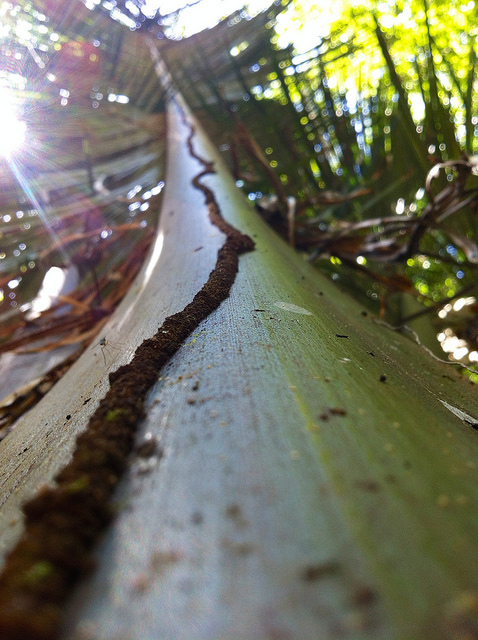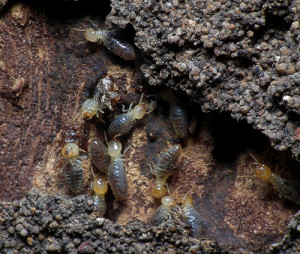What Do Termite Tubes Look Like?
By Chris Williams on June 18, 2014.

Termites’ mud tube running up a tree.
Sometimes the first indication that termites are infesting your home is the presence of mud…that was not brought in by your kids. Subterranean termites and mud go together.
Why Do Termites Build Tubes?
Termites are soft-bodied insects; they don’t have that hard outer shell that beetles and many other insects possess. Consequently, termites are very susceptible to drying out. They can’t survive long in the open air. That’s why they live in soil, feed inside wood, and travel between the two using mud tubes that they have constructed from a mixture of soil and a glue-like fecal material. The tubes protect them from enemies like ants, and from air circulation that would dry out their bodies as they commute to work.
Different Tubes For Different Uses
Termites make different kinds of mud tubes, depending on their purpose. Shelter tubes or working tubes are the most common tubes that termites use to travel from soil to wood. They’re about ¼ to ½ inch wide and vary in length. Working tubes can be found on the surface of foundation walls (inside or outside), beams, and sill plates, and along pipes or other supports. Often, tubes are constructed in a crack or crevice, so what you see may not look much like a tube. From your perspective, it looks like dirt packed into a crack.
An exploratory tube is narrow and thin and has many branches and forks that often go only a short distance. If an exploratory tube reaches susceptible wood, it may be reinforced and widened, becoming a working tube.
Termite drop tubes are less common. You can find these tubes suspended down from wood to soil in protected places like crawlspaces. Even rarer are free-standing tubes, sometimes several inches in length, built from the soil up to wood. Both drop and free-standing tubes are often surrounded by pieces of earlier tubes that fell. Finally, termites build a specialized swarming tube (also called a “castle”) that they use as a launching pad when winged termite swarmers are leaving the soil colony.
How to Tell if the Termite Infestation is Active
Fresh, newly constructed tubes will be moist. Old tubes will be dry and brittle and break easily. If you break an active tube open, you will see a scramble of termite soldiers in the tube, arriving to guard the breach. Worker termites will work very quickly to repair a broken tube that they are still using.
However, just because a single tube appears old and unused, don’t assume that means the termites have left the building. Infesting termites will build and abandon tubes as they move into new areas. And you can still have a termite infestation without finding mud tubes. Sometimes the tubes are hidden, or not even necessary if termites can reach wood directly from the soil. If you find what you think are termite tubes, call a professional exterminator for a termite inspection.
Tube photo credit: qcom / Foter / Creative Commons Attribution-ShareAlike 2.0 Generic (CC BY-SA 2.0)
Termites photo credit: James Niland / Foter / Creative Commons Attribution 2.0 Generic (CC BY 2.0)
